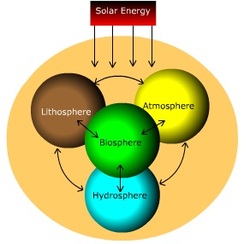Discover the Amazing World of Environment !!
Environment: In simple language; environment is surrounding world of us and it’s directly or in directly affect us to live on the earth. It cover both Natural or manmade practice.
The word of environment:
- Environment became a popular issue with the publication of Rachel Carson’s (Box No.1.1.) landmark book Silent Spring (Houghton Mifflin, Boston 1960, 1962).
- The word environment is derived from the French word environ which means encompass or encircle.
- The environment includes the surroundings, conditions or influences that affect an organism (growth and development).
- The word environment is derived from; entoure meaning that which surrounds.
- Word environment is most commonly used to describe natural environment and means the sum of all living (biotic) and non-living (abiotic) things that surround an organism or group of organisms. Environment often changes after some time.
- The physical and biological factors along with their chemical interactions that affect an organism.
Types of Environment
1. Natural Surroundings
- Made by nature.
- Includes air, water, soil, sunlight, forests, rivers, animals, etc.
2. Human-Created Surroundings
- Created by humans.
- Includes houses, roads, factories, schools, vehicles, etc.
Natural surroundings refer to everything provided by nature itself. These elements work together to make life possible. It includes:
-
Landforms
-
Water bodies
-
Air
-
Soil
-
Wildlife
This part of the world is made up of four major components:
1. Biosphere – The Life Zone
The biosphere includes all living organisms: plants, animals, microbes, and humans. Life exists in regions of land, air, and water — where interactions support survival and energy flow.
2. Atmosphere – The Air Layer
A mixture of gases surrounds the Earth, protecting us from harmful radiation and maintaining a stable climate. It provides oxygen, carbon dioxide, and helps in weather patterns.
3. Lithosphere – The Solid Surface
This is Earth’s outer shell, made of rocks, minerals, and land features like mountains and plains. It supports agriculture, habitation, and supplies natural resources.
4. Hydrosphere – The Water Domain
Comprises oceans, rivers, lakes, glaciers, and underground water. Although water covers about 71% of the planet, only a small portion is usable fresh water.

1. Biosphere – The Life Zone of Earth
The biosphere is the part of the Earth where life exists. It includes all living things like plants, animals, humans, insects, fungi, and microorganisms. These living things interact with each other and with their surroundings — air, water, and land.
- It includes parts of the land (lithosphere), water (hydrosphere), and air (atmosphere) where life can survive.
- The biosphere is very important because it supports life and allows the flow of energy and nutrients.
- Forests, grasslands, deserts, oceans, and wetlands are all part of the biosphere.
2. Atmosphere – The Blanket of Air
The atmosphere is the layer of gases that surrounds the Earth. It protects us and makes life possible by giving us oxygen to breathe, carbon dioxide for plants, and protection from harmful sun rays.
- It is made up of gases like nitrogen (78%), oxygen (21%), and small amounts of carbon dioxide, argon, and water vapor.
- The atmosphere also helps in controlling the Earth’s temperature and weather patterns.
- It has different layers: troposphere, stratosphere, mesosphere, thermosphere, and exosphere.
3. Lithosphere – The Solid Land Surface
The lithosphere is the solid outer part of the Earth. It includes the crust and the upper part of the mantle. It is made of rocks, soil, minerals, and landforms.
- This is where we build our houses, roads, and cities.
- It provides natural resources like coal, oil, metals, and soil for agriculture.
- Mountains, valleys, plateaus, deserts, and plains are part of the lithosphere.
4. Hydrosphere – The Water World
The hydrosphere includes all the water on Earth. This includes oceans, seas, rivers, lakes, glaciers, underground water, and water vapor in the atmosphere.- Water is essential for drinking, farming, cleaning, and supporting aquatic life.
- About 71% of the Earth’s surface is covered by water, but only a small amount is freshwater that we can use.
